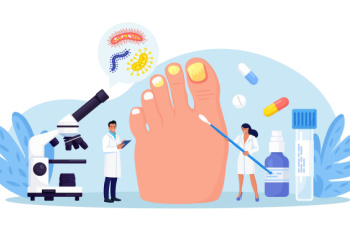
Wilmington (937) 382-2347
(513) 791-4764
Fax
(513) 932-1606

Wilmington (937) 382-2347
(513) 791-4764
Fax
(513) 932-1606

Toenail fungus, medically termed onychomycosis, is a common fungal infection that affects millions of people worldwide. Fungi thrive in warm, moist environments, making the feet susceptible to infection, particularly in damp socks and shoes. When fungi, such as dermatophytes, yeasts, or molds, penetrate the toenail bed or nail plate, they cause the toenail to become discolored, thickened, and brittle. Fungal nail infections often start as a small white or yellow spot under the nail and progressively spread, leading to more severe symptoms if left untreated. Factors like poor foot hygiene, wearing tight or ill-fitting shoes, and walking barefoot in public places increase the risk of toenail fungus. Additionally, individuals with weakened immune systems, diabetes, or circulatory issues are more prone to fungal infections. If you have developed toenail fungus, it is suggested that you consult a podiatrist who can offer effective preventive measures, in addition to prescribing medication if needed for successful treatment.
For more information about treatment, contact Dr. Gerald Perelman of Ohio. Our doctor can provide the care you need to keep you pain-free and on your feet.
Toenail Fungus Treatment
Toenail fungus is a condition that affects many people and can be especially hard to get rid of. Fortunately, there are several methods to go about treating and avoiding it.
Antifungals & Deterrence
Oral antifungal medicine has been shown to be effective in many cases. It is important to consult with a podiatrist to determine the proper regiment for you, or potentially explore other options.
Applying foot powder on the feet and shoes helps keep the feet free of moisture and sweat.
Sandals or open toed shoes – Wearing these will allow air movement and help keep feet dry. They also expose your feet to light, which fungus cannot tolerate. Socks with moisture wicking material also help as well.
If you have any questions please feel free to contact our office located in Wilmington, OH . We offer the newest diagnostic tools and technology to treat your foot and ankle needs.